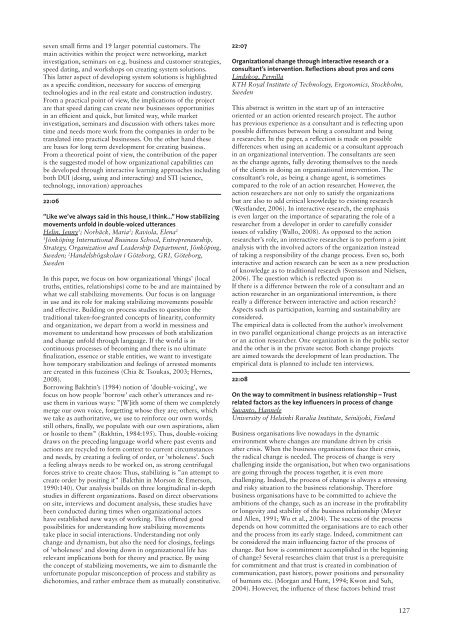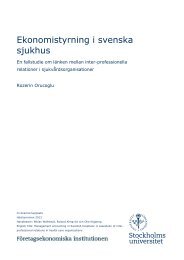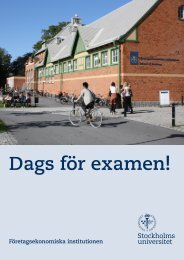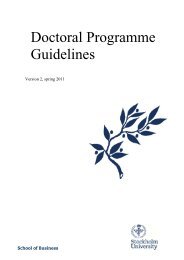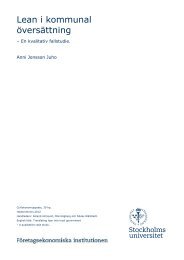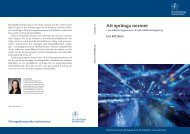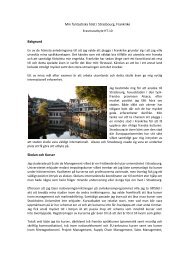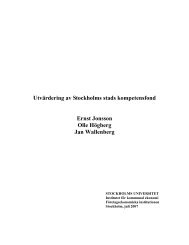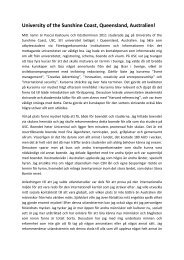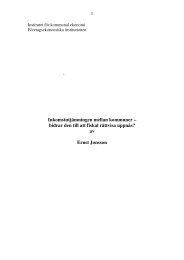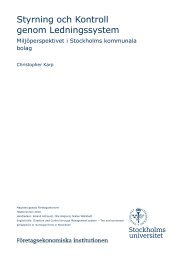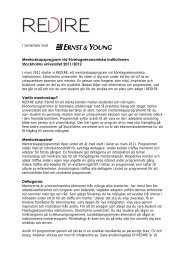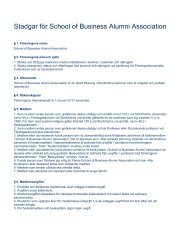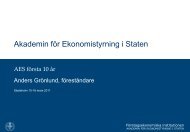Download full programme and abstract book pdf 1.6
Download full programme and abstract book pdf 1.6
Download full programme and abstract book pdf 1.6
You also want an ePaper? Increase the reach of your titles
YUMPU automatically turns print PDFs into web optimized ePapers that Google loves.
seven small firms <strong>and</strong> 19 larger potential customers. The<br />
main activities within the project were networking, market<br />
investigation, seminars on e.g. business <strong>and</strong> customer strategies,<br />
speed dating, <strong>and</strong> workshops on creating system solutions.<br />
This latter aspect of developing system solutions is highlighted<br />
as a specific condition, necessary for success of emerging<br />
technologies <strong>and</strong> in the real estate <strong>and</strong> construction industry.<br />
From a practical point of view, the implications of the project<br />
are that speed dating can create new businesses opportunities<br />
in an efficient <strong>and</strong> quick, but limited way, while market<br />
investigation, seminars <strong>and</strong> discussion with others takes more<br />
time <strong>and</strong> needs more work from the companies in order to be<br />
translated into practical businesses. On the other h<strong>and</strong> these<br />
are bases for long term development for creating business.<br />
From a theoretical point of view, the contribution of the paper<br />
is the suggested model of how organizational capabilities can<br />
be developed through interactive learning approaches including<br />
both DUI (doing, using <strong>and</strong> interacting) <strong>and</strong> STI (science,<br />
technology, innovation) approaches<br />
22:06<br />
”Like we’ve always said in this house, I think...” How stabilizing<br />
movements unfold in double-voiced utterances<br />
Helin, Jenny 1 ; Norbäck, Maria 1 ; Raviola, Elena 2<br />
1 Jönköping International Business School, Entrepreneurship,<br />
Strategy, Organization <strong>and</strong> Leadership Department, Jönköping,<br />
Sweden; 2 H<strong>and</strong>elshögskolan i Göteborg, GRI, Göteborg,<br />
Sweden<br />
In this paper, we focus on how organizational ’things’ (local<br />
truths, entities, relationships) come to be <strong>and</strong> are maintained by<br />
what we call stabilizing movements. Our focus is on language<br />
in use <strong>and</strong> its role for making stabilizing movements possible<br />
<strong>and</strong> effective. Building on process studies to question the<br />
traditional taken-for-granted concepts of linearity, conformity<br />
<strong>and</strong> organization, we depart from a world in messiness <strong>and</strong><br />
movement to underst<strong>and</strong> how processes of both stabilization<br />
<strong>and</strong> change unfold through language. If the world is in<br />
continuous processes of becoming <strong>and</strong> there is no ultimate<br />
finalization, essence or stable entities, we want to investigate<br />
how temporary stabilization <strong>and</strong> feelings of arrested moments<br />
are created in this fuzziness (Chia & Tsoukas, 2003; Hernes,<br />
2008).<br />
Borrowing Bakhtin’s (1984) notion of ’double-voicing’, we<br />
focus on how people ’borrow’ each other’s utterances <strong>and</strong> reuse<br />
them in various ways: ”[W]ith some of them we completely<br />
merge our own voice, forgetting whose they are; others, which<br />
we take as authoritative, we use to reinforce our own words;<br />
still others, finally, we populate with our own aspirations, alien<br />
or hostile to them” (Bakhtin, 1984:195). Thus, double-voicing<br />
draws on the preceding language world where past events <strong>and</strong><br />
actions are recycled to form context to current circumstances<br />
<strong>and</strong> needs, by creating a feeling of order, or ’wholeness’. Such<br />
a feeling always needs to be worked on, as strong centrifugal<br />
forces strive to create chaos: Thus, stabilizing is ”an attempt to<br />
create order by positing it” (Bakthin in Morson & Emerson,<br />
1990:140). Our analysis builds on three longitudinal in-depth<br />
studies in different organizations. Based on direct observations<br />
on site, interviews <strong>and</strong> document analysis, these studies have<br />
been conducted during times when organizational actors<br />
have established new ways of working. This offered good<br />
possibilities for underst<strong>and</strong>ing how stabilizing movements<br />
take place in social interactions. Underst<strong>and</strong>ing not only<br />
change <strong>and</strong> dynamism, but also the need for closings, feelings<br />
of ’wholeness’ <strong>and</strong> slowing down in organizational life has<br />
relevant implications both for theory <strong>and</strong> practice. By using<br />
the concept of stabilizing movements, we aim to dismantle the<br />
unfortunate popular misconception of process <strong>and</strong> stability as<br />
dichotomies, <strong>and</strong> rather embrace them as mutually constitutive.<br />
22:07<br />
Organizational change through interactive research or a<br />
consultant’s intervention. Reflections about pros <strong>and</strong> cons<br />
Lindskog, Pernilla<br />
KTH Royal Institute of Technology, Ergonomics, Stockholm,<br />
Sweden<br />
This <strong>abstract</strong> is written in the start up of an interactive<br />
oriented or an action oriented research project. The author<br />
has previous experience as a consultant <strong>and</strong> is reflecting upon<br />
possible differences between being a consultant <strong>and</strong> being<br />
a researcher. In the paper, a reflection is made on possible<br />
differences when using an academic or a consultant approach<br />
in an organizational intervention. The consultants are seen<br />
as the change agents, <strong>full</strong>y devoting themselves to the needs<br />
of the clients in doing an organizational intervention. The<br />
consultant’s role, as being a change agent, is sometimes<br />
compared to the role of an action researcher. However, the<br />
action researchers are not only to satisfy the organizations<br />
but are also to add critical knowledge to existing research<br />
(Westl<strong>and</strong>er, 2006). In interactive research, the emphasis<br />
is even larger on the importance of separating the role of a<br />
researcher from a developer in order to care<strong>full</strong>y consider<br />
issues of validity (Wallo, 2008). As opposed to the action<br />
researcher’s role, an interactive researcher is to perform a joint<br />
analysis with the involved actors of the organization instead<br />
of taking a responsibility of the change process. Even so, both<br />
interactive <strong>and</strong> action research can be seen as a new production<br />
of knowledge as to traditional research (Svensson <strong>and</strong> Nielsen,<br />
2006). The question which is reflected upon is:<br />
If there is a difference between the role of a consultant <strong>and</strong> an<br />
action researcher in an organizational intervention, is there<br />
really a difference between interactive <strong>and</strong> action research?<br />
Aspects such as participation, learning <strong>and</strong> sustainability are<br />
considered.<br />
The empirical data is collected from the author’s involvement<br />
in two parallel organizational change projects as an interactive<br />
or an action researcher. One organization is in the public sector<br />
<strong>and</strong> the other is in the private sector. Both change projects<br />
are aimed towards the development of lean production. The<br />
empirical data is planned to include ten interviews.<br />
22:08<br />
On the way to commitment in business relationship – Trust<br />
related factors as the key influencers in process of change<br />
Suvanto, Hannele<br />
University of Helsinki Ruralia Institute, Seinäjoki, Finl<strong>and</strong><br />
Business organisations live nowadays in the dynamic<br />
environment where changes are mundane driven by crisis<br />
after crisis. When the business organisations face their crisis,<br />
the radical change is needed. The process of change is very<br />
challenging inside the organisation, but when two organisations<br />
are going through the process together, it is even more<br />
challenging. Indeed, the process of change is always a stressing<br />
<strong>and</strong> risky situation to the business relationship. Therefore<br />
business organisations have to be committed to achieve the<br />
ambitions of the change, such as an increase in the profitability<br />
or longevity <strong>and</strong> stability of the business relationship (Meyer<br />
<strong>and</strong> Allen, 1991; Wu et al., 2004). The success of the process<br />
depends on how committed the organisations are to each other<br />
<strong>and</strong> the process from its early stage. Indeed, commitment can<br />
be considered the main influencing factor of the process of<br />
change. But how is commitment accomplished in the beginning<br />
of change? Several researches claim that trust is a prerequisite<br />
for commitment <strong>and</strong> that trust is created in combination of<br />
communication, past history, power positions <strong>and</strong> personality<br />
of humans etc. (Morgan <strong>and</strong> Hunt, 1994; Kwon <strong>and</strong> Suh,<br />
2004). However, the influence of these factors behind trust<br />
127


